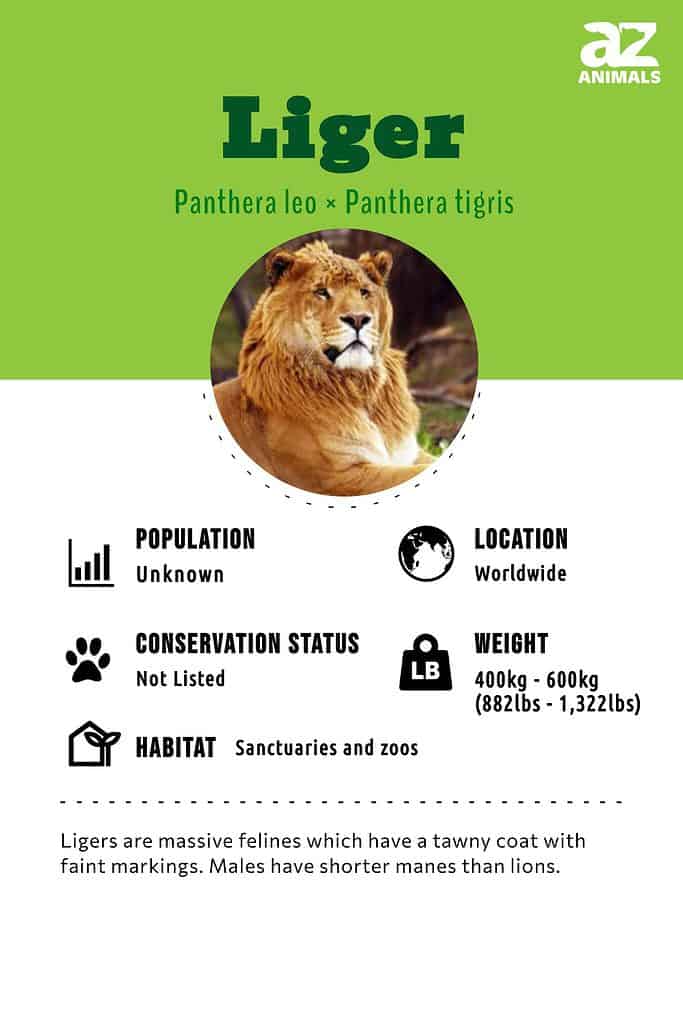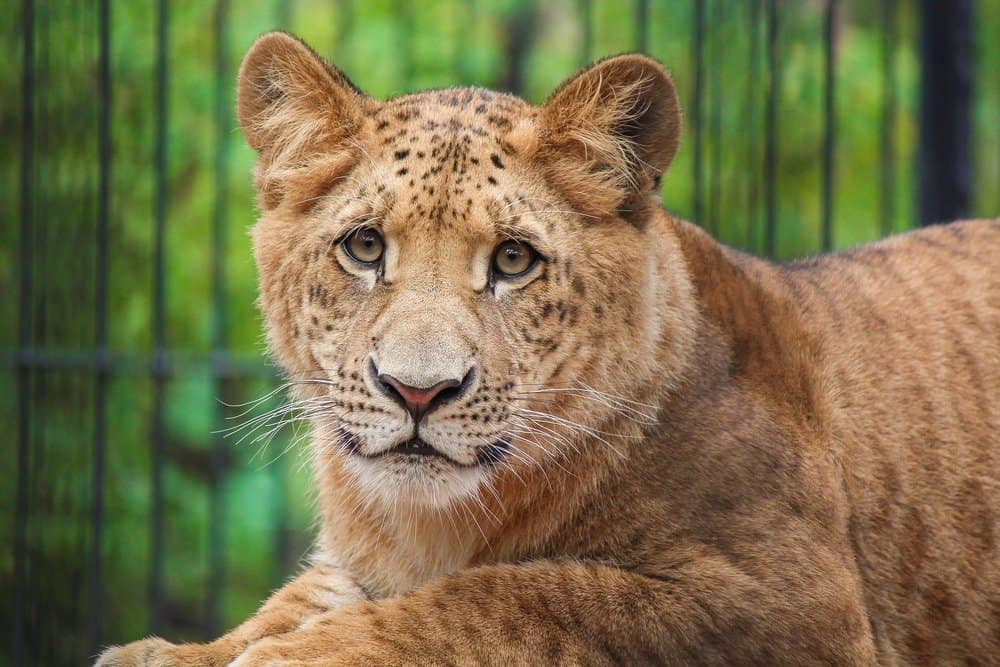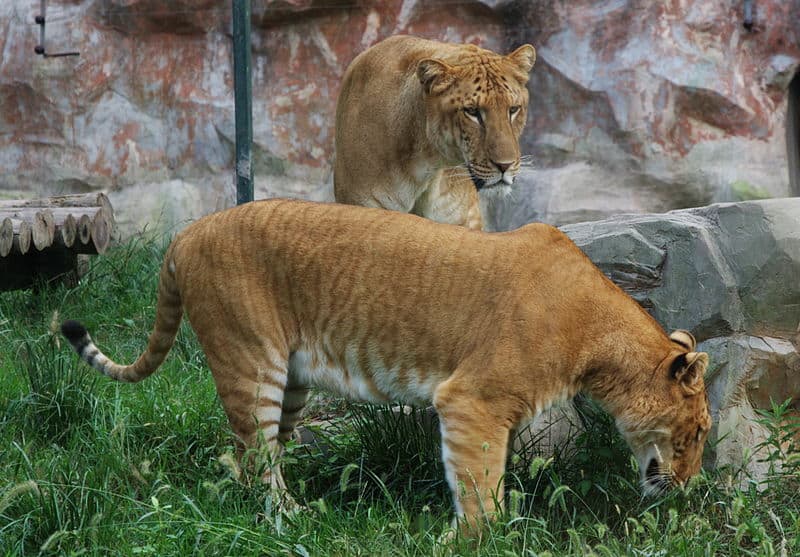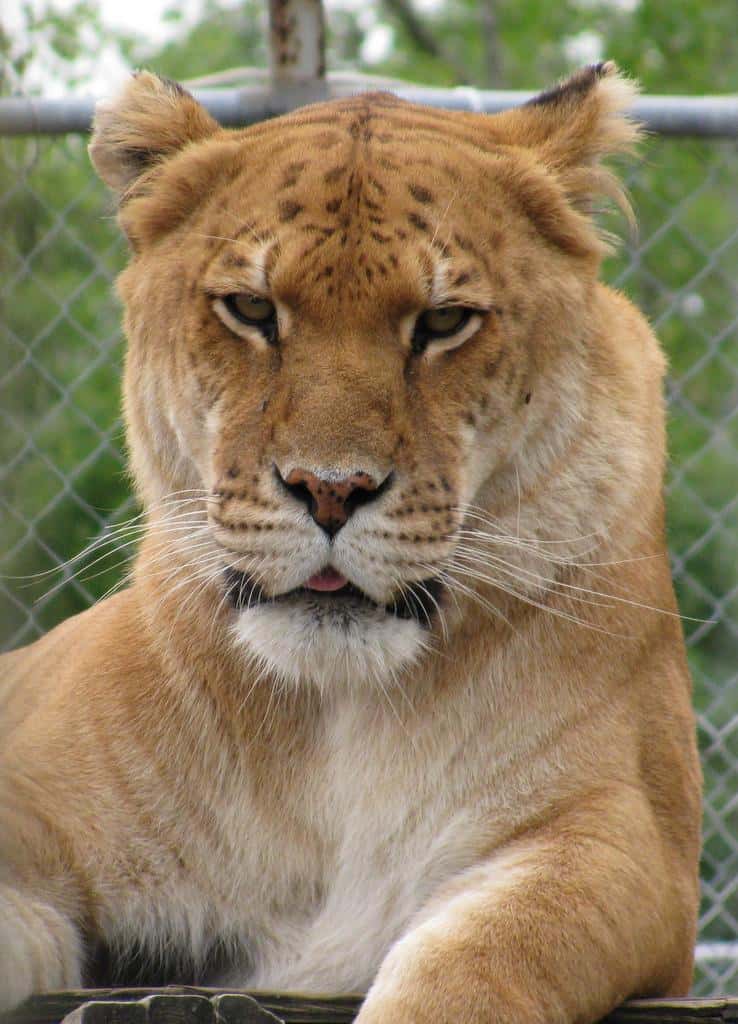Liger
Panthera leo × Panthera tigris
The offspring of a lion and tiger parents!
Advertisement
Liger Scientific Classification
- Kingdom
- Animalia
- Phylum
- Chordata
- Class
- Mammalia
- Order
- Carnivora
- Family
- Felidae
- Genus
- Panthera
- Scientific Name
- Panthera leo × Panthera tigris
Read our Complete Guide to Classification of Animals.
Liger Conservation Status
Liger Facts
- Prey
- Deer, Wild Boar, Cattle
- Name Of Young
- Cub
- Group Behavior
- Solitary
- Fun Fact
- The offspring of a lion and tiger parents!
- Estimated Population Size
- Not known
- Biggest Threat
- Commercial breeding
- Most Distinctive Feature
- Enormous head and body size
- Gestation Period
- 100 days
- Habitat
- Do not occur in the natural world
- Diet
- Carnivore
- Lifestyle
- Diurnal/Nocturnal
- Common Name
- Liger
- Number Of Species
- 1
- Location
- Zoos
- Slogan
- The offspring of a lion and tiger parents!
- Group
- Mammal
Liger Physical Characteristics
- Color
- Brown
- Black
- Tan
- Orange
- Skin Type
- Fur
- Top Speed
- 50 mph
- Lifespan
- 18 - 22 years
- Weight
- 400kg - 600kg (882lbs - 1,322lbs)
- Age of Sexual Maturity
- 3 - 4 years
- Age of Weaning
- 6 months

Key Facts
- Most ligers are born when a lion happens to share living quarters with a tigress.
- They are capable of reaching a height of 12 feet when they stand on their hind legs.
- Female ligers are more likely to be fertile as opposed to male ligers which have always been known to be sterile.
Classification and Evolution

Ligers are not likely to occur in the wild
©iStock.com/yod67
The Liger is the largest of the world’s felines, known to grow up to 12ft tall when standing on their hind legs. Created by the mating of a male Lion with a female Tiger, Ligers tend to far exceed the size of both of their parents and although they share similar characteristics with both of them, the Liger tends to be more like a Lion rather than a Tiger.
Related: 12 Hybrid Animals That Are Actually Real
A Tigon is the result of breeding a female Lion with a male Tiger, with this animal tending to be less like a Lion having more Tiger-like qualities. Due to the fact though that Lions and Tigers live in different areas of the world, it is very unlikely that Ligers (or Tigons) are animals that would occur naturally in the wild. Today there are a handful of Ligers found in zoos around the world, which are a result of either accidental or deliberate Human intervention.
Anatomy and Appearance

Ligers inherit the coat patterns of their mother
©Lizov Ivan/Shutterstock.com
The Liger is an enormous animal with a large muscular body and broad head. Ligers tend to have sandy or dark yellow fur which is covered in the distinctive faint stripes inherited from their mother. Although other variations in fur color have been known (including white when their mother is a White Tiger), the Liger generally has a more Lion-like appearance including the manes of the males. Although a Liger’s mane is not as big or as impressive as that of an adult Lion, they can grow quite large on some individuals but it is not uncommon for a male Liger to have no mane at all. Along with their stripes which tend to be most noticeable around their hind quarters, the Liger may also inherit the spots found on the backs of Tiger’s ears along with the tufted fur around their chins.
Distribution and Habitat

In nature, tigers and lions are unlikely to mate although it may have been possible for them to do so in the past
©AkulininaOlga/Shutterstock.com
Historically it could have been possible although rare, for a male Lion to mate with a female Tiger in the wild to produce Liger offspring. This is because the Asiatic Lion once roamed across a much larger portion of Asia meaning that they could have more easily wandered into a Tiger’s territory. Today however, Tigers are only found in the dense jungles of Asia where they are being pushed into smaller and smaller pockets of their natural habitat. Lions on the other hand, are found patrolling the African grasslands with the exception of the few remaining Asiatic Lions, which are found in a remote forest in India where there are no Tigers. Sadly, although the natural habitat of the Liger would probably be fairly similar to that of a Tiger, the world’s only known Ligers are found in caged enclosures.
Behavior and Lifestyle

A case of deceiving appearances, ligers are relatively easygoing by nature
Despite their gigantic size and the fact that their parents are two of the planet’s most ferocious predators, the Liger is an animal that is known to have a relatively gentle and docile nature, particularly when interacting with handlers. They have however been reported to be slightly confused as to whether or not they are Lions or Tigers as their most bewildering characteristic is the fact that they seem to love water. In the wild, it is not uncommon for Tigers to enter the water either to catch prey or to cool down in the heat and so they are naturally good swimmers, which is something that the Liger seems to have inherited. Lions do not like water however and so it is often reported that it does take some time for the Liger to take to its water-loving lifestyle. Another odd thing is the fact that the Liger appears to make both Lion and Tiger noises but its roar is more like that of a Lion’s.
Reproduction and Life Cycles

Liger cubs have a low rate of survival
Most Ligers are created through the accidental introduction of Lions and Tigers in the same enclosure although it can take up to a year for the two to mate. After mating the male Lion with the female Tiger, the Tiger gives birth to a litter of between 2 and 4 Liger cubs after a gestation period that lasts for about 100 days. As with the young of other large felines, the Liger cubs are born blind and are incredibly vulnerable, relying heavily on their mother for their first 6 months of life. As with Lion cubs, young Ligers have darker spots on their fur which helps to provide them with extra camouflage. However, as with some adult Lions, these spots often remain on Ligers and are most prominent on their underside. Many Liger cubs are sadly born with birth defects and often don’t survive for longer than a week.
Diet and Prey

Ligers are capable of tucking immense quantities of meat away
©Camphora – Public Domain
Like the rest of the world’s felines, the Liger is a carnivorous animal meaning that it hunts and kills other animals in order to gain its nutrition. Although the wild diet of the Liger can only be presumed, it is thought to be similar to that of a Tiger mainly hunting larger herbivores including Deer, Wild Boar and (due to their immense size) possibly small or vulnerable Asian Elephants. In captivity they tend to eat an average of 20lbs of meat a day but it is thought that a Liger would easily devour 100lbs worth of food in one sitting. The Liger has an enormous and incredibly strong jaw with sharp, pointed teeth which are ideal for tearing through flesh. Ligers also have very muscular bodies and sharp claws which also help them to catch and eat their prey.
Predators and Threats
If they were found in the wild, the Liger would be the most dominant predator in their environment and would therefore have no natural predators to worry about, with the obvious exception of Humans. Much like Lions and Tigers, Ligers would be subjected to both hunting for trophies and their fur, along with severe habitat loss throughout much of what would be their natural range. In captivity, many Liger cubs are born with fatal birth defects due to the fact that it is the result of the cross-breeding of two different species. Another problem to consider is the unnatural nature in which Ligers are both bred and kept all around the world. As it is highly unlikely that Ligers can occur in the wild today, they are merely being bred and kept by zoos in order to make money.
Interesting Facts and Features
Although like many other hybrids Ligers tend to be sterile, it has been known for a female Liger to be able to produce offspring but a fertile male Liger has never been recorded. She will either be bred with a male Lion or a male Tiger to either produce a litter of Li-Liger or Ti-Liger offspring depending on the species of the father. One of the most famous Ligers is a Hollywood creation named Hercules, which is the offspring of a male Lion and a female Tiger in an institute in Florida. At the age of three he stood at 10ft tall when on his hind legs and weighed half a ton. Another reason as to why Ligers would be rarely produced in the wild is that if a male Lion and a female Tiger came across one another, they are much more likely to fight to defend their territory or avoid one another completely in order to risk getting hurt.

Ligers are generally bred by accident
Relationship with Humans
The Liger has been bred by people since the early 19th century when a litter of Liger cubs was born in Asia in 1824. It was more than 100 years however until the next recorded litter which was in a zoo in South Africa just before World War II. Although Ligers are known to be quite even tempered, there remains a great deal of controversy over the cross-breeding of two different animal species, particularly when it is so highly unlikely to occur without Human intervention. Today there are a number of Ligers found in zoos and animal institutes around the world, which are bred (generally by accident) and kept as a money-making attraction.
Conservation Status and Life Today
As there is no real scientific name assigned to the Liger due to the fact that it is made from cross-breeding two separate species artificially, and that is it is not found in the wild, the Liger has no conservation status. The Liger is found in only a handful of enclosures on the planet but they remain frowned upon by many as they do not exist in the wild and therefore have no value as such to conservation. Tigons are more rarely found than Ligers today however, in the late 19th and early 20th centuries there were more of them than there were Ligers. The breeding of Ligers is now banned in a number of countries around the world.
View all 98 animals that start with LLiger FAQs (Frequently Asked Questions)
Are Ligers herbivores, carnivores, or omnivores?
Ligers are Carnivores, meaning they eat other animals.
What Kingdom do Ligers belong to?
Ligers belong to the Kingdom Animalia.
What class do Ligers belong to?
Ligers belong to the class Mammalia.
What phylum to Ligers belong to?
Ligers belong to the phylum Chordata.
What family do Ligers belong to?
Ligers belong to the family Felidae.
What order do Ligers belong to?
Ligers belong to the order Carnivora.
What type of covering do Ligers have?
Ligers are covered in Fur.
What genus do Ligers belong to?
Ligers belong to the genus Panthera.
Where do Ligers live?
Ligers live in zoos.
In what type of habitat do Ligers live?
Ligers do not occur in the natural world.
What are some predators of Ligers?
Predators of Ligers include humans.
What is an interesting fact about Ligers?
Ligers are the offspring of a lion and a tiger!
What is the scientific name for the Liger?
The scientific name for the Liger is Panthera leo or Panthera tigris.
What is the lifespan of a Liger?
Ligers can live for 18 to 22 years.
What is a baby Liger called?
A baby Liger is called a cub.
How many species of Liger are there?
There is 1 species of Liger.
What is the biggest threat to the Liger?
The biggest threat to the Liger is commercial breeding.
How many Ligers are left in the world?
The population size of the Liger is unknown.
How fast is a Liger?
A Liger can travel at speeds of up to 50 miles per hour.
What is the difference between a liger and a tiger?
The main differences between ligers and tigers include their size, weight, appearance, behavior, roar distance, and lifespan. Ligers are born from a hybrid of a lion and a tiger, thus their similar appearance with tigers. Like tigers, ligers also belong to the genus Panthera which encompasses all spotted wild cats that have specific anatomical structures that help them roar.
Thank you for reading! Have some feedback for us? Contact the AZ Animals editorial team.
Sources
- David Burnie, Dorling Kindersley (2011) Animal, The Definitive Visual Guide To The World's Wildlife
- Tom Jackson, Lorenz Books (2007) The World Encyclopedia Of Animals
- David Burnie, Kingfisher (2011) The Kingfisher Animal Encyclopedia
- Richard Mackay, University of California Press (2009) The Atlas Of Endangered Species
- David Burnie, Dorling Kindersley (2008) Illustrated Encyclopedia Of Animals
- Dorling Kindersley (2006) Dorling Kindersley Encyclopedia Of Animals
- David W. Macdonald, Oxford University Press (2010) The Encyclopedia Of Mammals
- Liger Hybrid Facts, Available here: http://www.helium.com/items/934943-liger-facts-hybrid-of-lion-and-tigress
- Largest Liger, Available here: http://www.worldamazinginformation.com/2007/10/worlds-largest-liger-liontiger.html
- About Ligers, Available here: http://www.lairweb.org.nz/tiger/ligers.html
- Liger Information, Available here: http://www.liger.org/

















